THE ARCHITECTURE OF THE COMMON TASK
THE SHOCK OF MODERNITY
The relationship between cosmism and architecture requires a wider framing of these subjects within the context of European modernity. Modernity was a shock. Despite debates around subsequent periodizations of modernity, including most notably late modernity and post-modernity, contemporary Europe still tries to grasp what was distinctively special about modernity in social and philosophical terms. What does it mean to be modern? In the late 19th and early 20th centuries, modernity in the European context came to designate the rationalization, industrialization, and liquidation of traditional (mainly peasant and aristocratic) modes of living, standardization, and mapping of social relations.[1] Modernity was experienced by European societies at different tempos and processes as a wave, an intrusion of new modes of social interaction. New philosophical and political concepts arose; new conceptions of time and space became predominant as new social problems became more pressing: industrialization meant problems around economics, logistics, infrastructures, grant scales, populations and population density, and issues of hygiene. Modernity was not only a new philosophy that somehow fetishized a contrast with the “past”. It was, in material terms, a wave of novel apparatuses and corresponding social issues.
Modernity was more of a question than an answer. As it is already well documented, modernity, in cultural terms, caused two main reactions: one was technological enthusiasm, a delirium around the new possibilities that rationalization opened up. This was a kind of progressivism widely celebrated. The other one was a deep concern about the liquidation of traditional forms of life and social equilibrium: a fear that (European) humanity may be entering an era of liberated social and physical forces that are beyond its control and whose destructive capacity may be way higher than what societies can withstand. According to this fear, modernity, at least in some of its aspects, was to be avoided and evaded, giving way to social conservatism. Roughly speaking, two opposite idealizations of society overcoming the predicaments of modernity had been formed: a utopia of a totally rationalized society, the idea that the solution to modernity was more modernity, and the opposite, the utopia of returning to an idealized version of the past, a utopia looking backwards.
It has to be noted here that it would be a mistake to identify these two extremes with left- and right-wing politics, respectively. Depending on local social conditions, progressivism and conservatism had left, center, and right-wing variants across Europe, making the political landscape of the early 20th century an ideological labyrinth.
Russia, in general terms, was no exception. Appearing at the end of the 19th century, modernization disrupted the social equilibrium in an otherwise deeply traditionalist country. Urbanization, hygiene, technological innovation, and social mobility, among other issues, started to play a predominant role in the social and political life of the late Russian Empire. Russia had its own progressivist social forces, that is, forces leaning around the political center and the left, and, of course, its own traditionalists like the autocracy but also the radical leftists of the Narodnik tradition. The intelligentsia, a social stratum inevitably linked with progressive social reforms, was experiencing an intellectual contradiction since it was the product of progressive reforms but was also more keen on highlighting the dangers of modernization. It was at this time that inside the intelligentsia, different variants of religious philosophy appeared, trying to reconcile the imminent rationalization of social life—an aspect closely linked with secularization—and religious feeling. Religion in Russia was not just a dominant ideology. It was a set of beliefs, practices, rituals, and apparatuses that functioned as a form of political legitimization and the construction of a common identity in an otherwise vast state. Political debates were usually formulated in religious terms as early as the 17th century. Religion was considered a pivotal factor of social cohesion, and a possible loss of this social connecting tissue was seen by many as an adversity. The concept of sobornost‘, the idea of a spiritual community united by a shared religious feeling and identity, emerged in this theoretical constellation.[2]
DREAMING, BELIEVING, AND THE REDS: THE COMMON TASK
Revolutionary or not, anti-state or not, religious philosophy was a specific Russian response to modernity and an ideological labyrinth in its own right. In this theoretical landscape, though, a specific articulation stands out: cosmism.
Cosmism was the result of a non-contradictory, combinational way of thinking, an assemblage. It was an attempt to overcome the polarity between rationalization and religious feeling, between progressivism and conservatism. Technological progress and the social and psychical forces inaugurated by modernization were not viewed as the opposite of the traditional Russian religious worldview but as their fulfillment. The messianic promise of the End of History, a crucial but omitted aspect of Christian eschatology, was given a new spin, interpreted as the universalization of technological and industrial processes. Industrialization and science were not to be neglected but welcomed. This was also called the philosophy of the Common Task[3] by the “founding father” of cosmism, Nikolai Fedorov, a common, unifying project for all humanity to solve its most common and fundamental existential problem: mortality and war. Cosmism, thus, can be said to be a peculiar variant of techno-existentialism. Fedorov saw the advancements in medicine as the historical fulfillment of the divine promise of the triumph over death, the literal, material raising of the dead, and the endless prolongation of life. The colonization of other planets (expansion of space) was understood as a solution to the social roots of war conflicts. Nevertheless, cosmism was not a homogeneous body of thought in any way. Fedorov and subsequent prominent cosmists such as Alexandr Svyatogor and Konstantin Tsiolkovsky developed different articulations of cosmism. Some of them, especially Fedorov, had a more explicit religious element, while others, such as Tsiolkovsky, attributed a more predominant role to technology. Nevertheless, in all of them, specific themes common to Christian religious thinking can be observed, such as universalism, the dialectical tension and relation between the Sky (God, the ideal of a perfect being) and Earth (humanity, necessity, imperfection), and the linear conception of Time progressing towards an end. These centuries-old symbols were to be conquered by rational, material means.
Christian universality, a mere formality in previous times of religious fragmentation between sects, dogmas, and denominations, signified in cosmism the idea of a planetary technological grid and a corresponding universalist culture, a cultural and infrastructural unification. This religious futurism, even though it began with unclear political inclinations, gradually came to be more associated with other social forces that advocated rapid technological advancement in the Russian context. After the October Revolution of 1917, these forces were de facto consolidated around the Bolshevik project and the early debates about the form and role of technology in the first socialist state of the world. Konstantin Tsiolkovsky became the founder of the Soviet rocket research program in 1935. Svyatogor came to openly endorse the Soviet power, declaring Soviet support as a precondition for the further development of the cosmic agenda. Alexandr Bogdanov was already a prominent member of the Bolsheviks during the Revolution. The event of the Revolution itself was viewed by some pro-revolutionary religious theorists, including the cosmists, as a messianic event. In these circumstances, the fusion of religion, rationalism, socialist progressivism, and cosmism was, to some extent, inevitable.
THE SUBLIME OF STONES AND CONCRETE: NEW ARCHITECTURE FOR A NEW STATE
Since early modernity, the reorganization of society had an implicit or, at times, explicit relationship to architecture and urban planning. In the utopian modern imagination, the desire to overcome the accumulated social contradictions of modernity had specific spatial depictions. From the act of separating the land of utopia from the rest of the world in order to organize it in a different way in the early modernist literature of Thomas More’s Utopia to more recent, applied experimental elaborations, such as the projects of Robert Owen and Jean-Baptiste André Godin,[4] utopia was keen on projecting itself in architectural terms.[5]
This had to do with the international popularity that theories on behavioral experimental psychology and its relation to space received in the 19th and early 20th centuries, but also with the fact that early modern, chaotic industrial cities were considered by many of their contemporaries not only as examples of a not fully rational society, full of contradictions and conflicts, but as the cause of these discontents. Thus, this reasoning could be –and was– reversed: the ideal city, that is, an ideal architecture of the built environment, was an indispensable component of an ideal society.[6] This argument could be pushed even further in the socialist context: the ideal socialist society meant, among other things, living and building the ideal socialist city, so the debate about the appropriate form of the socialist city in the 1920s and early 1930s in the USSR, resulted in widespread and heated discussions of this subject among specialists.[7] Nevertheless, the concept of an ideal city remained vague and it had to be defined if it was to be implemented. Thus, questions about how an ideal socialist city can be imagined, and how far can this imaginative, speculative act can go became essential. These idealizations of cities were often oscillating between total administration/organization and total freedom from administration, where the latter regards the endless expansion of movement, expression and liberation from temporality. This was also the case with the architectural interpretation of cosmism.
It was at this moment and in this context that the so-called ‘soviet paper architecture’ made its appearance, being from its very beginning, destined to stay on paper. But paper architecture was a language constituting a ῾beyond’: it was mostly a mapping of possible futures, a translation of the unknown into an intelligible language of the present. Paper architecture thus stands somewhere between materiality and abstraction, actual presence and virtuality. As a language, it does not communicate a given content. Rather it creates content in a relational and temporal manner between agents of communication, expressing evaluations and counter-evaluations over a never ending chain of hypotheses of meaning. This linguistic modality enables not only habitual and conventional functions, but also less habitual functions such as philosophical speculation, poetic imagination and expression, literature, and so on. As such, language can grasp not only the empirically given, the actual but also the possible, that is the virtual possibilities around a given situation. It creates worlds in relation but also beyond the given, and sometimes shutters the given world with its shocking conceptions of novel possibilities. So inside language always lurks the prospect of the poetic, the aesthetic, the artistic.[8] It is what, around the same time, the futurist Victor Sklovski had termed de-familiarization of a given worldview through art. Paper architecture is better understood as a form of aesthetic, architectural pictographic language. It was not just unrealizable plans. As such, it was supposed to function in a dialectical manner with material reality. It was a trigger of imagination.
SKYSCAPES AND LANDSCAPES: KRUTIKOV AND LEONIDOV
Paper architecture emerged in Russian at the same time and in the same intellectual atmosphere as the theoretical trend of cosmism. Both had a common denominator in that they speculated about ideal futures and the relationship between modern productive technologies and modes of sociality, about the old and the new, modern world. So, in particular instances, utopian urban speculations came into contact with cosmic themes, resulting in two very specific cases of paper architecture: Georgy Krutikov’s and Ivan Leonidov’s projects.
Georgy Krutikov, a student at the Vkhutemas Institute of Architecture, was one of the pioneers of the 1920s. He considered that one of the duties of an architect was to design unrealizable projects, as this would push the socialist forces of production forward. Thus, in 1926, he presented his thesis titled “The Flying City”. Krutikov surprised many in the architectural milieus in Moscow at the time, some unpleasantly, by designing a city that was entirely in the air at a time when the USSR had an inchoate air force. The flying city was characterized by a set of structures in balloons that flew within a kilometer of the earth’s surface. On a circular base there were structures like multi-story buildings with individual apartments that could be detached from the structure and, like missiles, travel to other “neighborhoods”. Between the buildings, there was supposed to be a regular zeppelin connection. The entire structure was anchored to the earth in a production facility. The inhabitants of the flying city only came down to earth to work.[9] Krutikov’s project had a great influence on the architectural ideas in the 1930s in the Soviet Union. This influence can be seen first of all in the fact that after Krutikov, two more Vkhutemas graduates Isaak Jozefovich and Viktor Kamilkov, designed diploma projects on the theme of flying cities or buildings.
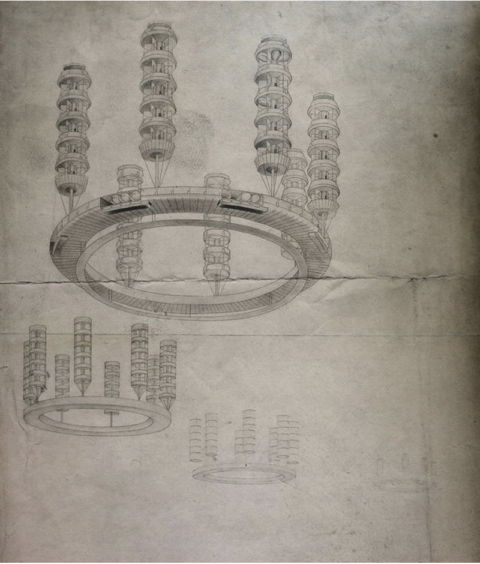
Krutikov’s flying City, (Selim Khan-Magomendov, Georgii Krutikov: The flying city)
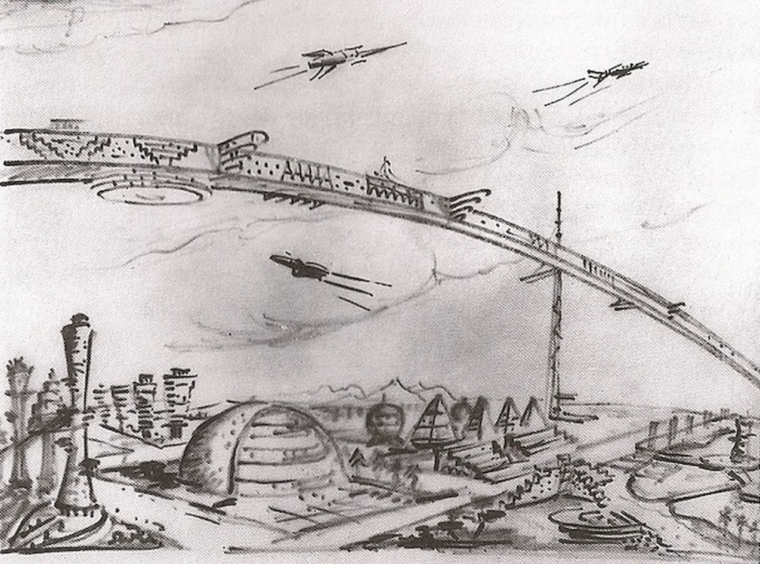
Viktor Kalmikov-Saturnii project, 1929. (Selim Khan-Magomendov, Victor Kalmikov, tvortsi avantgarda)
There is no doubt that Krutikov’s and his descendants’ idea of flying cities was influenced by cosmism and the general enthusiasm for flying.[10] Тhe idea of ascension and conquest of the sky was an aesthetic and mainly symbolic attempt to promote productive forces and inspire projects of progress and transcendence. They were architectural designs in the classical sense but also aesthetic utopias, aesthetic gestures that evoked in anyone who saw them a sense of de-familiarization and awe.
This act of de-familiarization was accomplished in Krutikov’s drafts by staging first and foremost a spectacle of radical imaginary for their times. Krutikov and his followers create structures and objects that are completely unfamiliar to the general public: planes, air balloons, and zeppelins. The depiction of these objects and machines was completely otherworldly, and even the suggestion that these machines not only exist but will soon become a social standard was enough to inspire awe. However, a more nuanced tension exists and emerges when one examines Krutikov’s drafts: Krutikov employs mainstream architectural language, the detailed blueprint, to depict a completely fictitious and unrealisable project. He turns the mainstream architectural discourse (side views depicting girders and other supporting beams) against itself. Krutikov effectively disrupts the common modernist belief in architectural epistemology that ῾detailed’ denotes a specific set of concepts such as realisable, rational, standardized, and orderly, whereas vagueness denotes abstraction, speculation, and a lack of order. Krutikov writes and draws in a scientific manner. He intended to bridge the gap between speculation, artistic expression, utopian imagination, and science, technology, and realistic planning in this way. Thus, Krutikov does not simply incorporate cosmic themes of flying and space into his project, but he also attempts to overcome the division between two opposing and seemingly irreconcilable tendencies: utopia as a scientific project of orderly administration and utopia as freedom of movement and expression.
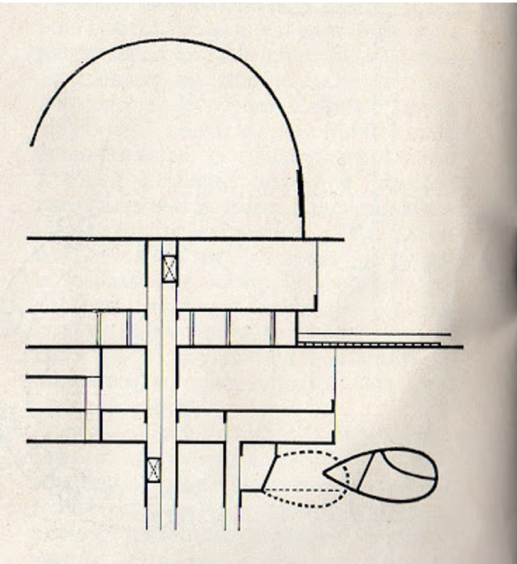
Krutikov’s flying City, side view of residential building and flying capsule, (Selim Khan-Magomendov, Georgii Krutikov: The flying city)
In the end, it can be said that Krutikov’s projects do not overcome this antithesis, but rather distribute it in specific parts of the project’s structure, with the two tendencies remaining distinct: the fact that this proposal was ultimately an “ideal industrial city” shows strong elements of administrative fantasies, where space is constructed to increase productivity. Not by chance, the first experiments in spatial psychology were conducted at the institute Krutikov studied, Vkhutemas, with the goal of studying industrial management, which was the Soviet equivalent of Fordism.[11] His project still reproduced a traditional (and religious) symbolic dualism, equating the earth with necessity and the sky with freedom. This dualism is simply translated into a modern, futuristic, and illustrative language. This is why Krutikov, in a moment of symbolic honesty, depicted the entire city in the clouds, except for one location: industry. Work was still viewed as the ultimate point of control; labour could not fly.
Ivan Leonidov was in turn an unusual case: as a pioneer architect, designer, and teacher, he systematized his ideas, which he published in the Soviet architectural journal CA (Contemporary Architecture). From his early projects to the post-war years, there was across his work a fixation with spheres and celestial objects. Spheres and a bird’s eye view can be seen in one of Leonidov’s earlier works, “The Entry of Lenin’s Institute in Moscow,” in 1927.[12] Khan Magomedov traces the origins of the Leonidov’s fascination with celestial objects in the Second World War[13] but more recent research dates the origins of this fixation back in 1931 when Leonidov spent one and a half year in Igarka, an experimental settlement in the extreme Russian North.[14] In strictly illustrative terms, the first drawing evoking the style and aesthetics of his later projects can be found in one of his Yalta compositions.[15] As a result, the precise date of the formation of his later ideas remains undetermined.
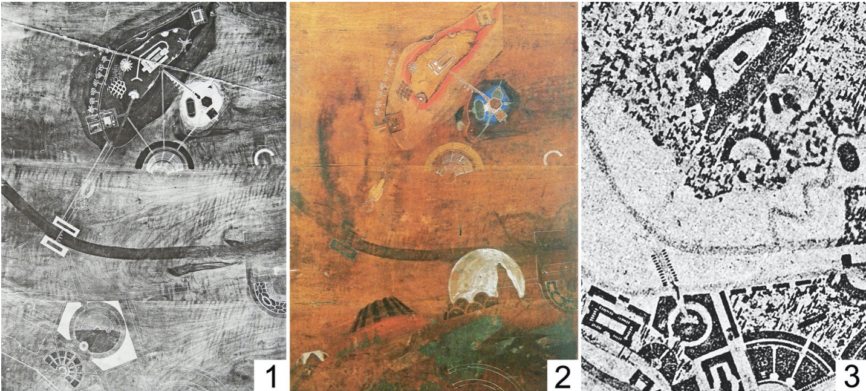
Extracts from Leonidov’s Yalta drawings 1936-1938. (Shchusev Museum of Architecture)
However, after WWII, his architectural speculations take on a more distinct and consistent character, which is now known as “City of the Sun.” The title, which was never used by Leonidov, was a direct reference to the European utopian literary tradition and Tommaso Campanella’s book by the same title. This book is, perhaps, along with More’s Utopia, one of the founding texts of utopian literature. We know that although he did not give his work this title, the book was one of Leonidov’s favorites and was explicitly linked to his projects. According to Campanella, the “City of the Sun” was a state that celebrated science as a god and understood that the content of the god was knowledge. Thus, the whole city was decorated with statues of writers and scientists. The city was ruled by a group of sages, following the Platonic model, who possessed all knowledge of mankind and managed the labor and sexual lives of the inhabitants in an optimally organized way. These sages resided in the centre of the city and were worshiped as incarnations of God-knowledge. Leonidov seems to have believed that the USSR was the historical application of Campanella’s model, ignoring its most authoritative aspects such as sexual regulation. He contemplated a unified humanity under the watchful eye of a wise humanist (socialist) elite. But this humanity would be unified both spiritually and infrastructurally in a common global city.
Leonidov’s “City of the Sun” was increasingly dominated over the years by one or more spherical bodies resembling the sun or other celestial objects. These objects appear to serve both symbolic and literal purposes: they serve a symbolic purpose in the aesthetic economy of the drawings, using the sun symbolization as the source of life on a planetary scale, an archetypal religious and cosmic motif especially in Bogdanov’s theory,[16] and literal purposes in the sense that Leonidov imagined that a unified humanity under a communist-cosmic rule would actually construct a “flying sun monument”, traveling from one planetary region to the other with help of the wind, representing and celebrating this very unification of humanity.[17] Leonidov’s images are not architectural blueprints. They have a hypnotic and mystical aesthetic, and lack the dynamism of other cosmic and, in general, futuristic imagery. Because of its shape, the spherical object appears to travel slowly, giving the impression of an endless, leisurely state of being. The global City of the Sun would unify the entire globe, transcending states and becoming the dominant political entity above and beyond states.
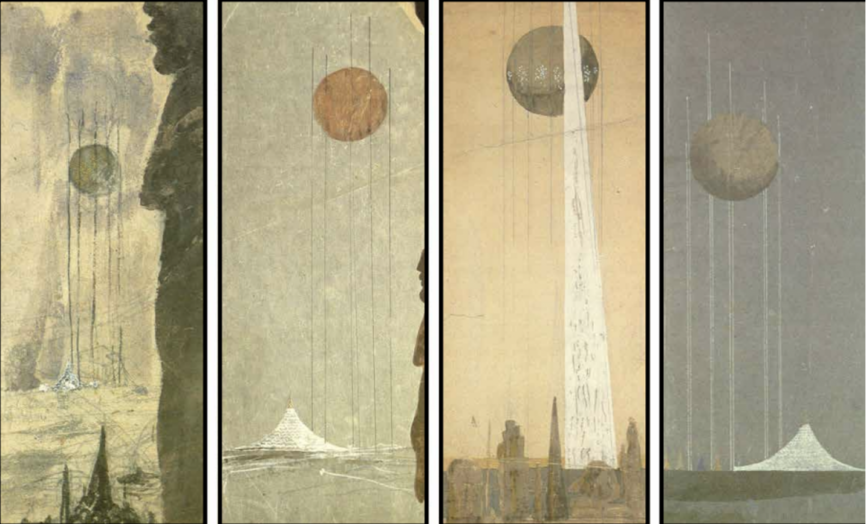
Distant views of the City of the Sun. 1943-1950 (Shchusev Museum of Architecture)
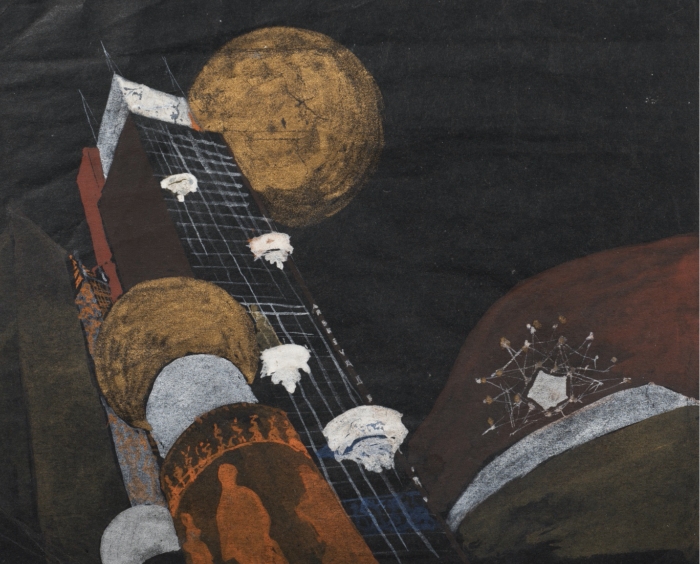
The sphere of the City of the Sun above Moscow. 1943-1950 (Shchusev Museum of Architecture)
In Leonidov’s conception, we can detect a noteworthy synthesis of utopian cosmic ideas. If we look at it from the point of view of the imaginary of administration related to a fully scientifically organized society, the work generally inscribes itself in administrative utopias (as also Campanella does). However, his aesthetics, show us something else, and in this ‘else’ Leonidov stands alone: the imposing dominance of celestial bodies in his drawings as well as the coloring, indicate an evident affinity to cosmism, and especially to its religious part. I follow here Ekaterina Bukharova who argues that there are clear religious and mystical references in Leonidov’s notes.[18] His drawings are colored similarly to classical Christian iconography, particularly that of the Eastern Orthodox tradition, an aesthetic that most residents of the USSR were familiar with. About the city itself, he believed that the City of the Sun would be a global city and that its geographical centre would be located somewhere in the East Indies (also a typically mystical, religious reference), and his drawings depict noticeable temple architecture elements, particularly pyramid-like buildings, towers, and eastern church temple elements.[19] Occasionally, they include depictions of actual churches juxtaposed with celestial man-made objects. Leonidov’s cityscape is an antithesis of sky and earth, mediated by man-made pikes and spheres. There are no pictorial or other types of references to concepts like labor, necessity, temporality or particularity. The City of the Sun gives the impression of something eternal and is an explicitly warless society, as one of the drawings titled “Monument of the last dead soldier of the last war” clearly demonstrates. Leonidov seems to have been motivated by a sense of consecration of science in favor of creating a spiritual community, a global sobornost’. This faith in science would be enough to unite all of humanity for a common task.[20]
The extent to which Leonidov’s original conceptions overlapped or were directly influenced by Fedorov is unknown because no textual direct reference to Fedorov has been revealed to date. Nonetheless, his concept of a global city representing a spiritually and infrastructurally united humanity and expressing this unity in wandering flying planet-like objects is quite similar to Fedorov’s, namely that a unified humanity through renewable energy infrastructures will be a warless society with a common, collective consciousness.[21] This planetary renewable energy infrastructure will make use of cosmic and global meteorological phenomena of objects and materials that “revolve just like the Moon around the planet Earth, even approaching quite near to its surface, then receding, circling it and undergoing even greater deviations and complex perturbations than the larger celestial bodies (planets and solar systems). Air currents can best be compared to streams of comets and, therefore, the meteorological process is also an astronomical phenomenon like the motion, course and progression of celestial bodies. Thus the regulation of the meteorological process already verges on the astronomical process. Regulation is a celestial Copernican task or art”.[22] Indeed, Leonidov and Fedorov appear to have a surprising number of specific similarities: global cities, planetary infrastructures, spiritual community, and a unification through the use of materials and objects circling the Earth. In the City of the Sun, these are reduced to a single symbolic object: the flying sphere.
AN EPILOGUE OF ECHOES
Neither Krutikov’s nor Leonidov’s ideas had an immediate application in actual city planning projects, and their influence during the Stalinist era significantly decreased. But after Stalinism, their echo could be heard in the calls of a better future—the rhythm that still shook the USSR during the 1960s. The re-emergence of modernism and the actual initiation of the space program resurrected cosmism. Even though its most apparent exemplification can be found in the monumental 1960s and 1970s Soviet art and architecture, especially in Ukrainian public mosaics, ideas such as the Soviet Mir Space Station can be thought to have their roots in these cosmic utopias. Also, whether or not cosmic ideas had a post-war influence on socialist monumental architecture outside the USSR remains an open question, as some buildings in Bulgaria, such as the Buzludzha communist monument, also known as the “Communist UFO,” and former Czechoslovakia’s Museum of the Slovak National Uprising during WWII in Banská Bystrica, appear to indicate.
Krutikov and Leonidov exemplify two different aspects of cosmism in early Soviet paper architecture. It can be said that Krutikov’s conception was more of a maximization of the enthusiasm for flying in early Soviet society (this was expected given his contact with Tsiolkovsky, a cosmist who was explicitly linked to flying technologies) while also descending towards an administrative utopian ideal. Leonidov’s City of the Sun, is probably the only fully cosmic conception of paper architecture. Even if traditional motifs of religious art can be easier to detect in his work, these serve only as a medium. In fact, the juxtaposition of the cultural connotations of this exact religious aesthetic with more explicit cosmic and holistic content (the consecration of science, the interpretation of the USSR as a rational but also spiritual community, the constant contrast between the aerial and terrestrial) destabilizes traditional divisions of concepts about the city, the nation-state, the rural, and most importantly, the dualism between religion and modern rationalization. Indeed, in Leonidov’s work as well as in cosmism in general, the final division that should be overcome is the duality between past and future, traditional and modern modes of life. The most apparent way that this was done was through Leonidov’s illustrations, in which he efficiently broke off from typical architectural drawing with its emphasis on technical detail. His illustration’s mystical atmosphere and iconographic connotations serve as an open-ended aesthetic gesture, eliminating the instrumentality of detail. It introduces obscurity and poetic freedom while still speaking about science, communities, and cities. It turns architectural drawing not just into depictions of cosmism but into a cosmic way of depiction.
Cosmism had an impact on more than just Leonidov and Krutikov as architects and artists. Others, such as Konstantin Melnikov and Vladimir Tatlin, were familiar with cosmism. However, it was only in Leonidov’s and Krutikov’s projects that cosmism became the primary lens through which architecture and ideas about better futures for society were explicated. Only in these two cases can we speak of “cosmic architecture.” Cosmism was a philosophy, a delirium, and a platform for the most outlandish theories. Dream cities and societies were the focus of cosmic paper architecture. Their synthesis was driven by a desire for universal salvation, something which is no longer present in public discourse. Studying cosmic architecture today sheds light first and foremost on the connections between the ideas of the October Revolution and pre-revolutionary movements, on the common but also contradictory threads of modernity. But beyond purely research interest, it raises the question of what is the utopia of our times and what is the creative intellectual milieu of architecture, art, and literature today. What is considered “new” and “old” in our day and age? What role could technology and renewable energy play in a post-national-state global future? Cosmism is still a “radical other” to our social reality today, but it lacks a widely accepted language of articulation, such as early Soviet paper architecture. We did, technically, reach the stars, but only for military purposes, not for any kind of reconciliation. The common task is still awaiting its architectural, technical, and political expression, appropriate for our own time. Under the sun, up in the skies and down on earth, the global city still awaits its builders and citizens.
x
Dimitris M. Moschos is a Greek PhD researcher with a focus on the social policy of the urban space and the comparative study of state policies between different state regimes. His main research interest is the interrelationship between utopia, state policies, and urban planning. He focuses on the history of the New Towns Movement in Britain and Eastern Europe during the socialist period. He was born in Athens, Greece, in 1987. He studied history and archaeology, with a specialization in the history of Eastern Europe and political philosophy. He has translated in Greek works of literature, history, and political philosophy from Bulgarian, Russian, German, and English. He has published articles in academic and non-academic journals in Greece and abroad.
REFERENCE LIST
[1] Scott James. C, Seeing like a state, (New Haven: Yale University Press, 1998): 3-7.
[2] Rosenthal, Bernice Glatzer, “Lofty ideals and wordly consequences: visions of sobornost’ in early twentieth-century Russia,” Russian History, vol.20. no.1/4 , 1993, pp. 179-95.
[3] […]The ideal of progress, according to the learned, is to enable everybody to participate in the production and consumption of objects for sensual pleasure, whereas the aim of true progress can and must be the participation in a common task, the work of studying the blind force that brings hunger, disease and death in order to transform it into a life-giving force. In Nikolay Fedorov., What Was Man Created For? The Philosophy of the Common Task. Selected Works. Translated and abridged by Elizabeth Koutaissoff and Marilyn Minto, (London: Honeyglen. 1990): 14.
[4] Robert Owen, a British philanthropist and manufacturer, constructed ideal worker towns around cotton mills in the UK (New Lanark 1812) and the USA (New Harmony 1825). Both experiments eventually failed. Jean-Baptiste André Godin, also an industrialist and philanthropist had a similar idea in France, called familistère, a direct reference to Fourier’s phalanstère, a form of communal living in a planned residential complex and co-operative model of labor. Godin’s familistère were built in 1858 and in various forms they remained operational by the same initial workers and their families until 1968.
[5] Cowe Colin, Koetter Fred, Collage City, ( Cambridge: The MIT Press, 1978): 11-30.
[6] Hall Peter, Urban and Regional Planning, (London: Routledge, 1992): 61
[7] Steinberg Mark D, Russian Utopia, A century of revolutionary possibilities, (London: Bloomsbury Academic, 2021): 49-75.
[8] Flusser, Vilém, “Habit: the true aesthetic criterion,” in Writings, (Minneapolis: University of Minnesota Press, 2002): 51-57.
[9] Khan-Magomedov Selim, Pioneers of Soviet Architecture: the search for new solutions in the 1920s and 1930s, (New York: Rizzoli, 1987), 283-307.
[10] Hatton-Proulx Clarence, “From the Flying City to the Smart City: Techno-Utopian Planning in 1920s Soviet Union,” Strelka Mag, Accessed July 31, 2022, https://strelkamag.com/en/article/from-the-flying-city-to-the-smart-city.
[11] Bokov Anna, “Experiment Interrupted,” Palimpsest no. 5 (2014): 21.
[12] Honda, Akiko. “A New Vision in Architecture : Ivan Leonidov’s Architectural Projects between 1927 and 1930.” (2016).
[13] Khan-Magomedov Selim, Pioneers of Soviet Architecture: the search for new solutions in the 1920s and 1930s, 553-554.
[14] Бухарова Екатерина Александровна, “Образ Солнца в проектах архитектора Ивана Леонидова 1940-1950-х годов,” Академический вестник УралНИИпроект РААСН, no 3 (2014): 96-100.
[15] Пётр Завадовский. “Иван Леонидов в Крыму. 1936–1938. Часть 1,” in https ://archi.ru/russia/94120/ivan-leonidov-v-krymu—chast
[16] Bogdanov introduces one of the very first, and until now best articulated, theories of “sun philosophy” in his magnum opus, Tektology. This term refers to a philosophy that seeks to comprehend the relationships between living human and non-human organisms as a complex energy distribution mechanism, initially of solar energy. In fact, this is a philosophical articulation of ecological thinking that places humanity at the bottom of a complex network of interdependencies rather than at the top of a (intellectual and ontological) pyramid. Thus, humanity, particularly in its modern, industrial, and mass-consumption form, is not the pinnacle of material and intellectual evolution, but rather the most dependent agent, because it only consumes and does not contribute to the ecological network on which it is dependent. Thus, Bogdanov’s theory advocated for economic and population de-growth, rather than growth as in industrial societies.
[17] Бухарова Екатерина Александровна, “Образ Солнца в проектах архитектора Ивана Леонидова 1940-1950-х годов”
[18] Ibid.
[19] Бухарова Екатерина Александровна, “Феномен «космической архитектуры Ивана Леонидова: парковая лестница санатория НКТП им. С. Орджоникидзе в Кисловодске,” Академический вестник УралНИИпроект РААСН 1 (2011): 47-53.
[20] Lanini Luca, “The Infinite City. Vision and Reality in Ivan Leonidov’s Urban Designs,” in Creativity and Reality The art of building future cities, (Rome: Edisioni Nuova Cultura, 2021), 206-213.
[21] N. Fedorov, Common Task, Part II, § 1.
[22] Ibid see “On the unity of meteorological and cosmic processes.”